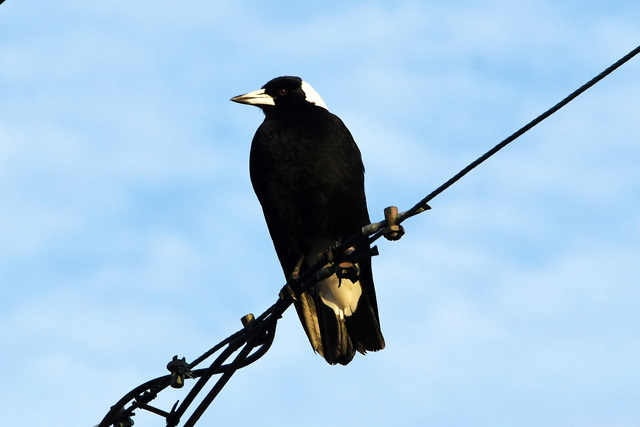In recent weeks as the weather has begun to turn residents across the Dandenong Ranges and Yarra Valley may have heard the sounds of magpies in the early morning.
On the night of a recent full moon in August, residents took to social media saying they had heard local magpies up vocalising in the night.
Star Mail journalist TANYA STEELE spoke with renowned emeritus professor Gisela Kaplan about the ‘pragmatic’ Australian birds and their melodic early morning (and sometimes late night) vocal habits, breeding behaviours and more.
Ms Kaplan said that over the years her research has shown magpies do tend to sing with lighter nights when the full moon is on show.
“That kind of warbling, that beautiful warbling that you hear, is in connection with light,” she said.
“It took me years to work all this out, it has no meaning in terms of territory, but it is more to celebrate the night – they’re going to their own party.”
Unlike other songbirds, the male and female birds both sing and they also do not sing at all when they are breeding.
“The magpies are just special,” she said.
The territorial birds don’t develop songs to impress a female – they have a territory to impress a female.
“So the magpie is extremely unusual in that sense,” said Ms Kaplan.
On the recent full moon, it was likely the magpies were just enjoying the light.
“When you hear that sort of more sort of tuneful warbling, that’s them just having a nice time,” she said.
“It has no particular function that we know, certainly not in terms of territory.”
Ms Kaplan said magpies don’t normally form morning choruses and they don’t normally sing together as a group.
If you have heard magpies vocalising together as a group, Ms Kaplan said it it usually more of a confirmation chorus.
“It’s an adult-only corroboree,” she said.
“We’ve identified the territorial call as a carolling, which is a very harsh sound.”
“What they do as a group is a chorus of confirmation of their territory, say they have just chased out a major predator, like an eagle, and they all come together, and they give a chorus, which is not a very beautiful song, but it is a confirmation of their victory, of their bonding, of their cooperation, and youngsters are not allowed to join in.”
Magpie carolling however is not very melodious and Ms Kaplan said it’s very loud and short and it can’t be confused with any normal song.
“It’s a slurring sort of sound,” she said.
“A male and female to whom the territory belongs will carol, which is a very loud call to just confirm that this is their territory.”
“It’s just in case somebody wants to invade – a male and female do that together.”
Ms Kaplan is an Emeritus Professor of Animal Behaviour in the School of Science and Technology at the University of New England.
She has authored over 250 research articles and 23 books. Her pioneering research focuses on vocal learning, communication, and cognition in birds and other vertebrates. As a prominent advocate for wildlife science, particularly regarding native birds, she frequently appears in public media.
In matters of breeding Ms Kaplan said males are the most unromantic lovers or partners you could ever imagine.
“They’re very, very good parents but the males don’t have any courtship,” she said.
“The female magpie will let the male know when she is ready to mate.”
“She takes her tail and swirls it around so that the right shows like a fan, from left to right very quickly.”
Ms Kaplan said that even at that point sometimes the male magpies don’t quite get the idea.
“On the courtship front, it’s nothing elaborate – but then they make for life,” she said.
The birds do not sing when they are breeding and Ms Kaplan said everything falls silent at breeding time.
“Magpies tend to sing outside the breeding season, and their most extensive singing behaviour is in summer when they’ve already raised their kids,” she said.
The iconic birds also have a universal call signal that is identical amongst magpies all over Australia and Ms Kaplan describes it as a ‘melodious’ little sequence.
“It’s not very long, but it’s very melodious and very soft and it what is called a ‘referential’ signal or a signal that is fixed in meaning, and it means food,” she said.
Magpies have around 960 distinct syllables that can produce distinct sounds and Ms Kaplan has written a 100,000 word PhD thesis just on vocal communication and song alone.
“Magpies also have an enormous repertoire – they can produce very different sounds because they have a musculature that very few birds have,” said Ms Kaplan.
“They can swap and use both sides of the syrinx (bird vocal chords) simultaneously, or swap so that they can produce different sounds on either at the same time, which is a remarkable feat,” she said.
“Nightingales can do it and magpies can do it, but very few others have been studied, and it’s unlikely that many others have that kind of versatility.“
“Magpies are also great mimics and Ms Kaplan herself has recordings of a magpie loudly exclaiming in a broad Australian accent “Go away”.
“They mimic very well,” she said.
The inquisitive and clever magpie features in many Indigenous myths – the Wurundjeri word for magpie is “Barrawarn” and a Western Australian dreamtime story from the Noongar people talks of how magpies helped to lift the sky.
“It’s a lovely, lovely story,” said Ms Kaplan.
In regards to their relationship with modern humans, Ms Kaplan said that the magpie is ‘pragmatic’.
“As long as the people are harmless – meaning, not dangerous and it’s a bonus when they’re nice,” she said.
“They are likely to share their space with you for the entire time you live in your house,” she said.
Ms Kaplan encouraged people to think beyond some of the common misconceptions of the magpie.
“Humans always think of fighting and conflict and aggression and most of the time, that’s just not true at all,” she said.







